Supporting the Smart Readiness Indicator—A Methodology to Integrate A Quantitative Assessment of the Load Shifting Potential of Smart Buildings
Abstract
1. Introduction
2. Background
2.1. Smart Readiness Indicator (SRI)
“…The smart readiness indicator should be used to measure the capacity of buildings to use information and communication technologies and electronic systems to adapt the operation of buildings to the needs of the occupants and the grid and to improve the energy efficiency and overall performance of buildings. The smart readiness indicator should raise awareness amongst building owners and occupants of the value behind building automation and electronic monitoring of technical building systems and should give confidence to occupants about the actual savings of those new enhanced-functionalities…”[10]
“…methodology shall rely on three key functionalities relating to the building and its technical building systems: (a) the ability to maintain energy performance and operation of the building through the adaptation of energy consumption for example through use of energy from renewable sources; (b) the ability to adapt its operation mode in response to the needs of the occupant while paying due attention to the availability of user-friendliness, maintaining healthy indoor climate conditions and the ability to report on energy use; and (c) the flexibility of a building’s overall electricity demand, including its ability to enable participation in active and passive as well as implicit and explicit demand response, in relation to the grid, for example through flexibility and load shifting capacities…”.[10]
2.2. Demand Response and Load Shifting in Buildings
2.3. Smart Buildings
“…A smart building is offering maximal quality of living with minimal consumption of resources by (1) exploiting architectural passive design measures to increase energy efficiency, by (2) joining internal and external systems and integrating renewable energy infrastructure and by (3) optimizing load management and load shifting to increase energy efficiency on all levels of the building, district or city…”.[37]
“…We can assess the load shifting potential of a building by calculating how much of the thermal and electrical energy can be loaded from the grid, stored and unloaded into the grid over a certain period of time whilst maintaining required comfort levels…”.[37]
3. Methodology
3.1. Description of the Model
3.1.1. System Boundaries
- Is there a grid with appropriate energy sources available?
- To what extent is the building able to communicate with the corresponding grid?
“What is the potential of the building to take energy from the grid, store it over a certain period of time and again dispatch it back to the grid?”
3.1.2. Description of the Indicator
- No grid available n/a.
- No interaction with the grid; activity coefficient 0.
- Passive interaction with the grid; activity coefficient 1.
- Active interaction with the grid; activity coefficient 2.
3.1.3. Description of the Model Functions
- L
- Lower asymptote.
- U
- Upper asymptote.
- G
- Growth rate.
- ν > 0
- Affects the growth near the asymptote.
- C
- Coefficient influencing Y(0).
- M
- Move the curve to the right.
- L = 0
- U = 1
- G = 6
- = 1
- C = 1
- M = 1
- ED
- Energy demand of the building per energy source for the selected time period τ.
- SC
- Storage capacity of the respective storage in the building.
- ηSC
- Efficiency factor of the storage capacity. (Here the efficiency for loading as well as unloading the storage must be considered). ηSC := ηC·ηD
- ηC
- Efficiency factor of the storage capacity for charge.
- ηD
- Efficiency factor of the storage capacity for discharge.
- ζSC
- Storage loss during the selected period in full storage (e.g., self-discharge, heat losses)
- AC
- Activity coefficient for the building.
3.2. Characteristics of the SRI Methdology
- There is a convergence of the SRI curve in respect to the upper and lower limit.
- The upper and lower limit can be freely selected.
- The period length τ can be freely selected: e.g., one day for a 24 h load profile or one year for a seasonal load profile, depending on the time period; the energy demand (ED) needs to be adjusted accordingly (e.g., for thermal loads the total heating energy demand would need to be divided by the heating days whereas for the total warm water energy demand this would need to be divided by 365 days if only a 24 h period is selected).
- Inclusion of system losses
- Inclusion of system efficiency
- The storage capacity is given in relation to the amount of energy, which is taken from the grid within a defined period.
- Query for the extent of interaction between the building and the grid. The query asks, whether the system can actively, passively or not at all interact with the grid (i.e., no grid available n/a; no interaction with the grid; activity coefficient 0; passive interaction with the grid; activity coefficient (1); active interaction with the grid; activity coefficient 2.
- E(t)
- Energy in the storage at the time t in kWh.
- P(t)
- Load Power in the storage at the time t in kW.
- PL(t)
- System losses kW.
- ηC
- Efficiency factor at charge.
- ηD
- Efficiency factor at discharge.
- ζSC
- Loss coefficient of the system.
- PN
- Rated power of the grid connection of the building in kW.
- SC
- Storage capacity in kWh.
- N
- Number of storage systems per energy type.
- ωi
- Weighting factor for i
- SCi
- Storage capacity of the respective storage i in the building.
- ηCi
- Efficiency factor of the storage capacity for charge of storage i.
- ηDi
- Efficiency factor of the storage capacity for discharge of storage i.
- ζSCi
- Storage loss during the selected period in full storage of storage i.
4. Application of the Methodology in Theoretical Use Cases
4.1. Description of Use Cases
- Use case 1: Single family building built in 1990; the building has not yet been refurbished, the external envelope is therefore poor compared to state of the art standards; the heating system is based on a typical floor heating system connected to district heating; no cooling; the building is not able to store thermal energy from the grid (activity coefficient 0 electrical; activity coefficient 0 thermal).
- Use case 2: Multi-storey residential building built in 2010; the quality of the external envelope is better than use case 1 with a resulting heating energy demand half of that of use case 1; the heating is equal to use case 1 with floor heating connected to district heating; no cooling; an electrical battery has been added; the building is able to store thermal energy from the grid in a water storage tank and to load and unload electrical energy from the grid (activity coefficient 2 electrical; activity coefficient 1 thermal;).
- Use case 3: office building built in 2010; external envelope to a high standard based on building regulations as of 2010; heating and cooling energy is generated by ground-coupled heat pumps; the building is connected to district heating; an electrical battery has been added; the building is able to load and unload electrical energy from the grid (activity coefficient 2 electrical; activity coefficient 1 thermal).
- Use case 4: office building to be built in 2020; external envelope twice as high as use case 3; the heating and cooling is equal to use case 3; in addition the system is connected to a district heating grid; a building integrated photovoltaic system is installed; an electrical battery has been added; the building is able to load and unload electrical as well as thermal energy to and from the grid (activity coefficient 2 electrical; activity coefficient 2 thermal).
4.2. Results of Use Cases
- Results of use case 1: The activity coefficient for all grids is 0, thus the SRI is similarly 0 as the building is not able to actively engage with the energy networks. The building is a simple consumer.
- Results of use case 2: Since the building can store energy from the thermal grid in a water tank but cannot actively discharge energy back to the thermal grid, the SRI thermal is below 1 and due to the limited storage capacity relatively low. The SRI electrical is with 1.81 high, since the electrical battery can actively store surplus energy from the grid and dispatch it back into the electrical network.
- Results of use case 3: The first example for the office building has similarly to use case 2 an activity coefficient of 2 for the electrical storage and an activity coefficient of 1 for the thermal storage system. This results in a SRI below 1 for the thermal connection and a just above 1 SRI for the electrical coefficient. The latter is due to the relatively small storage capacity of the electrical battery.
- Results of use case 4: This use case is the only one with an activity coefficient of 2 for both the thermal as well as the electrical connection. The resulting SRI of 2 shows that the electrical storage is at its limit for the charge and discharge of the electrical energy. The SRI thermal is with 1.91 relatively high due to the high thermal storage capacity of the system. It can be seen that compared to use case 3, the SRI is with a lower thermal storage capacity higher, due to the fact that in this use case, the system can charge as well as discharge thermal energy from the grid and is thus bi-directional.
5. Discussion
- SP
- Storage potential of the building (Relationship of SC/EB; dimensionless)
6. Conclusions
“…measure the capacity of buildings to use information and communication technologies and electronic systems to adapt the operation of buildings to the needs of the occupants and the grid and to improve the energy efficiency and overall performance of buildings…”.[10]
Author Contributions
Funding
Acknowledgments
Conflicts of Interest
References
- European Commission. COM(2011) 112 Final. A Roadmap for Moving to a Competitive Low Carbon Economy in 2050; European Commission: Brussels, Belgium; Luxembourg, 2011. [Google Scholar]
- European Commission. Policies, Information and Services, Energy/Topics/Buildings/Energy Efficiency/Buildings. Available online: https://ec.europa.eu/energy/en/topics/energy-efficiency/buildings (accessed on 10 March 2019).
- European Commission. COM(2016) 763 Final. Accelerating Clean Energy Innovation; European Commission: Brussels, Belgium; Luxembourg, 2016. [Google Scholar]
- European Commission. COM(2016) 860 Final, Annex 1. Accelerating Clean Energy in Buildings; European Commission: Brussels, Belgium; Luxembourg, 2016. [Google Scholar]
- European Commission—Fact Sheet; Towards Reaching the 20% Energy Efficiency Target for 2020, and Beyond. European Commission Press Release. 1 February 2017. Available online: http://europa.eu/rapid/press-release_MEMO-17-162_en.htm (accessed on 10 March 2019).
- Allouhi, A.; El Fouih, Y.; Kousksou, T.; Jamil, A.; Zeraouli, Y.; Mourad, Y. Energy consumption and efficiency in buildings: Current status and future trends. J. Clean. Prod. 2015, 109, 118–130. [Google Scholar] [CrossRef]
- Directive 2012/27/EU of the European Parliament and of the Council of 25 October 2012 on Energy Efficiency; L315/1-56; Official Journal of the European Union: Brussels, Belgium, 2012.
- Directive 2009/28/EC of the European Parliament and of the Council of 23 April 2009 on the Promotion of the Use of Energy from Renewable Sources; L140/16-62; Official Journal of the European Union: Brussels, Belgium, 2009.
- Directive 2002/91/EU of the European Parliament and of the Council of 16 December 2002 on the Energy Performance of Buildings; L1/65; Official Journal of the European Union: Brussels, Belgium, 2003.
- Directive (EU) 2018/844 of the European Parliament and of the Council of 30 May 2018 Amending Directive 2010/31/EU on the Energy Performance of Buildings Directive 2012/27/EU on Energy Efficiency; L156/75; Official Journal of the European Union: Brussels, Belgium, 2018.
- Verbeke, S.; Ma, Y.; Van Tichelen, P.; Bogaert, S.; Gómez Oñate, V.; Waide, P.; Bettgenhäuser, K.; Ashok, J.; Hermelink, A.; Offermann, M.; et al. Support for Setting Up a Smart Readiness Indicator for Buildings and Related Impact Assessment, Final Report; Study Accomplished under the Authority of the European Commission DG Energy 2017/SEB/R/1610684; Vito NV: Mol, Belgium, 2018. [Google Scholar]
- United Nations Climate Change. ‘Kyoto Protocol—Targets for the First Commitment Period’. Available online: https://unfccc.int/process/the-kyoto-protocol (accessed on 5 October 2018).
- Directive 2010/31/EU of the European Parliament and of the Council of 19 May 2010 on the Energy Performance of Buildings (Recast); L153/13; Official Journal of the European Union: Brussels, Belgium, 2010.
- Eurostat. ‘Greenhouse Gas Emissions Statistics—Emission Inventories’. Data from June 2018. Available online: https://ec.europa.eu/eurostat/statistics-explained/index.php/Greenhouse_gas_emission_statistics (accessed on 5 October 2018).
- Atanasiu, B.; Despret, C.; Economidou, M.; Maio, J.; Nolte, I.; Rapf, O. Europe’s Buildings under the Microscope, A Country-by-Country Review of the Energy Performance of Buildings; Buildings Performance Institute Europe (BPIE): Bruxelles, Belgium, 2011; ISBN 9789491143014. [Google Scholar]
- Aichele, C.; Doleski, O.D. Smart Markt, Vom Smart Grid Zum Intelligenten Energiemarkt; Springer Vieweg: Wiesbaden, Germany, 2014. [Google Scholar] [CrossRef]
- Madsen, H.; Holst, J. Estimation of continuous-time models for the heat dynamics of a building. Energy Build. 1995, 22, 67–79. [Google Scholar] [CrossRef]
- Andersen, K.K.; Madsen, H.; Hansen, L.H. Modelling the heat dynamics of a building using stochastic differential equations. Energy Build. 2000, 31, 13–24. [Google Scholar] [CrossRef]
- Bacher, P.; Madsen, H. Identifying suitable models for the heat dynamics of buildings. Energy Build. 2011, 43, 1511–1522. [Google Scholar] [CrossRef]
- Le Dréau, J.; Heiselberg, P. Energy flexibility of residential buildings using short term heat storage in the thermal mass. Energy 2016, 111, 991–1002. [Google Scholar] [CrossRef]
- Xu, Z.B.; Guan, X.H.; Jia, Q.S.; Wu, J.; Wang, D.; Chen, S.Y. Performance Analysis and Comparison on Energy Storage Devices for Smart Building Energy Management. IEEE Trans. Smart Grid 2012, 3, 2136–2147. [Google Scholar] [CrossRef]
- Berckmans, G.; Messagie, M.; Smekens, J.; Omar, N.; Vanhaverbeke, L.; Van Mierlo, J. Cost Projection of State of the Art Lithium-Ion Batteries for Electric Vehicles up to 2030. Energies 2017, 10, 1314. [Google Scholar] [CrossRef]
- Georgakarakos, A.D.; Mayfield, M.; Hathway, E.A. Battery Storage Systems in Smart Grid Optimised Buildings. Energy Procedia 2018, 151, 23–30. [Google Scholar] [CrossRef]
- Wulf, C.; Linßen, J.; Zapp, P. Review of Power-to-Gas Projects in Europe. Energy Procedia 2018, 155, 367–378. [Google Scholar] [CrossRef]
- Kohlhepp, P.; Hagenmeyer, V. Technical Potential of Buildings in Germany as Flexible Power-to-Heat Storage for Smart-Grid Operation. Energy Technol. 2017, 5, 1084–1104. [Google Scholar] [CrossRef]
- Lichtenegger, K.; Moser, A.; Muschick, D.; Reiterer, D.; Wöss, D.; Leitner, A. Einbindung von dezentralen Einspeisern in Wärmenetze, der Prosumer am Wärmemarkt. AEE Arbeitsgemeinschaft Erneuerbare Energie NÖ-Wien. Wien. 2018. Available online: http://www.aee-now.at/cms/fileadmin/downloads/projekte/bine2/Publikationen/Bine2plus%20Leitfaden%20final.pdf (accessed on 10 March 2019).
- Lund, H.; Ostergaard, P.A.; Chang, M.; Werner, S.; Svendsen, S.; Sorknaes, P.; Thorsen, J.E.; Hvelplund, F.; Mortensen, B.O.G.; Mathiesen, B.V.; et al. The status of 4th generation district heating: Research and results. Energy 2018, 164, 147–159. [Google Scholar] [CrossRef]
- Pooranian, Z.; Abawajy, J.H.; Vinod, P.; Conti, M. Scheduling Distributed Energy Resource Operation and Daily Power Consumption for a Smart Building to Optimize Economic and Environmental Parameters. Energies 2018, 11, 1348. [Google Scholar] [CrossRef]
- Degha, H.E.; Laallam, F.Z.; Said, B. Intelligent context-awareness system for energy efficiency in smart building based on ontology. Sustain. Comput. Inform. Syst. 2019, 21, 212–233. [Google Scholar] [CrossRef]
- Vigna, I.; Pernetti, R.; Pasut, W.; Lollini, R. New domain for promoting energy efficiency: Energy Flexible Building Cluster. Sustain. Cities Soc. 2018, 38, 526–533. [Google Scholar] [CrossRef]
- Rocha, P.; Siddiqui, A.; Stadler, M. Improving energy efficiency via smart building energy management systems: A comparison with policy measures. Energy Build. 2015, 88, 203–213. [Google Scholar] [CrossRef]
- Kolokotsa, D. The role of smart grids in the building sector. Energy Build. 2016, 116, 703–708. [Google Scholar] [CrossRef]
- Moseley, P. EU Support for Innovation and Market Uptake in Smart Buildings under the Horizon 2020 Framework Programme. Buildings 2017, 7, 105. [Google Scholar] [CrossRef]
- SETIS Strategic Energy Technologies Information System, 5th SET Plan Conference 2011. Available online: https://setis.ec.europa.eu/set-plan-conferences/5th-set-plan-conference-2011 (accessed on 10 March 2019).
- United Nations, Department of Economic and Social Affairs, Population Division. World Urbanization Prospects, the 2009 Revision; ESA/P/WP/215; United Nations: New York, NY, USA, 2010. [Google Scholar]
- Österreicher, D. A Methodology for Integrated Refurbishment Actions in School Buildings. Buildings 2018, 8, 42. [Google Scholar] [CrossRef]
- Österreicher, D. The Role of Smart Buildings for Energy Efficiency. Smart Buildings for a Greener Europe: Emerging Policy and Practice. Concerted Action Energy Performance of Buildings. La Valetta, Malta. 14.02.2017. Available online: https://www.epbd-ca.eu/wp-content/uploads/2017/02/2.-Doris-the-role-of-smart-buildings_170214.pdf (accessed on 26 September 2018).
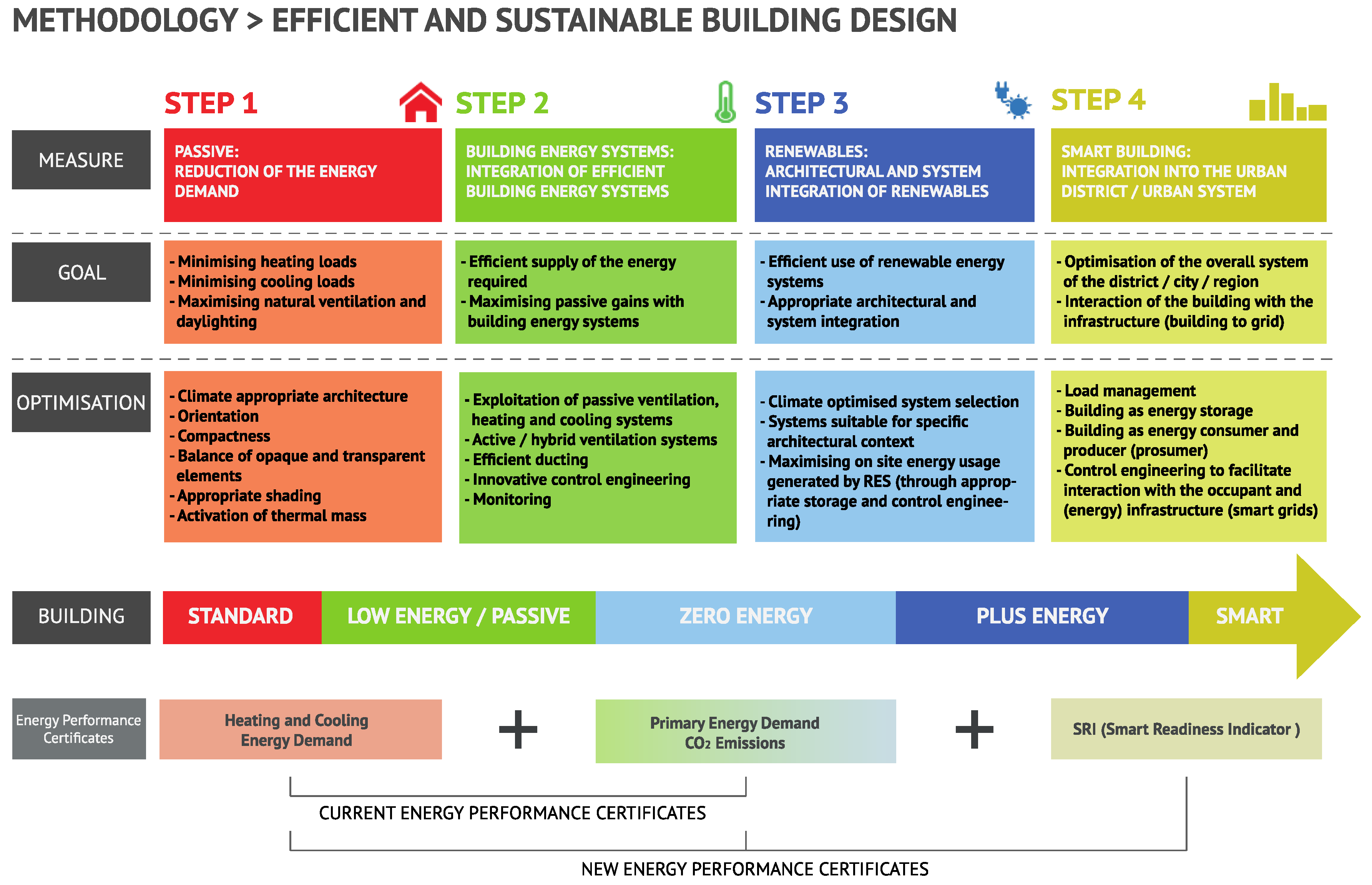




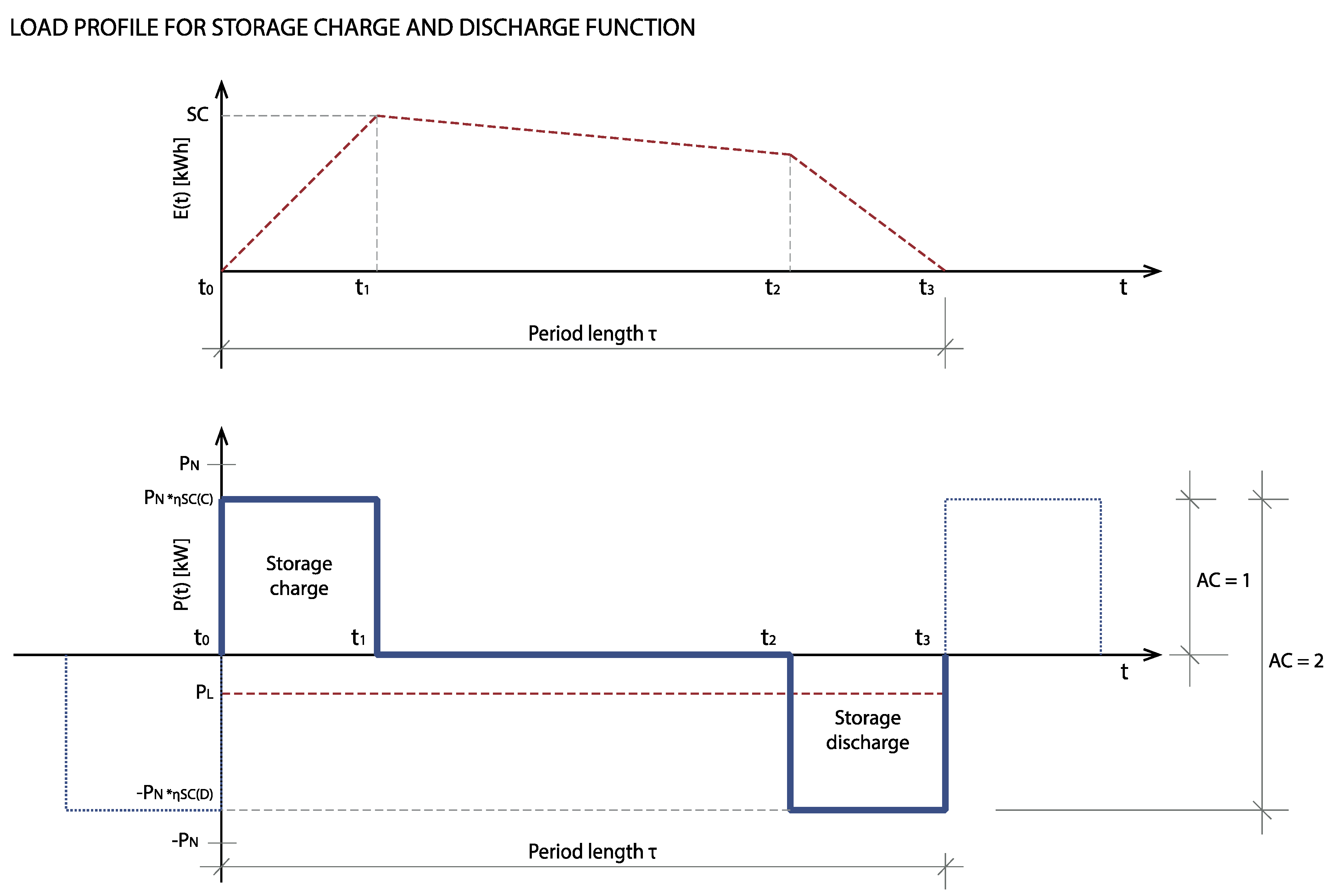
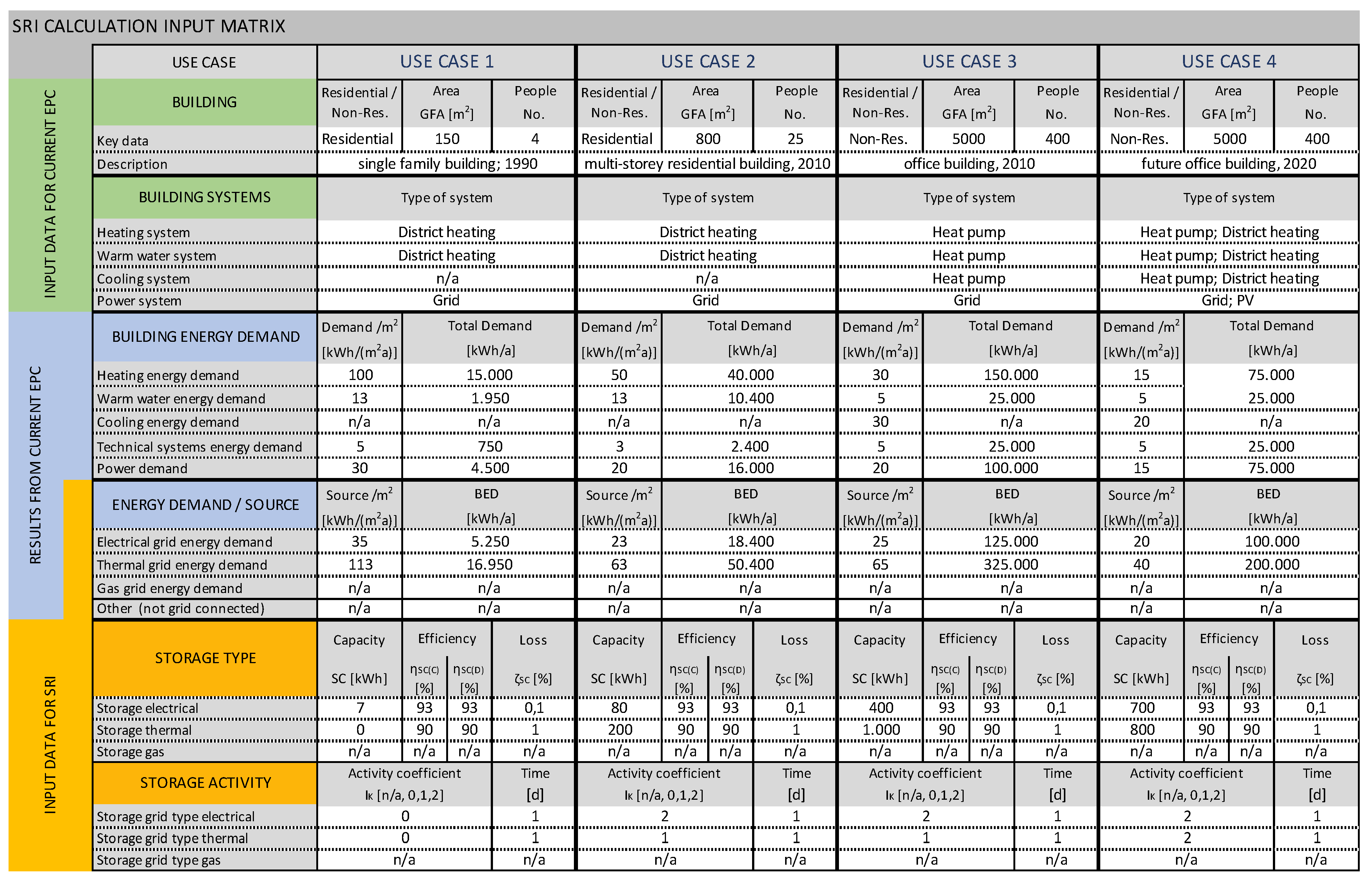
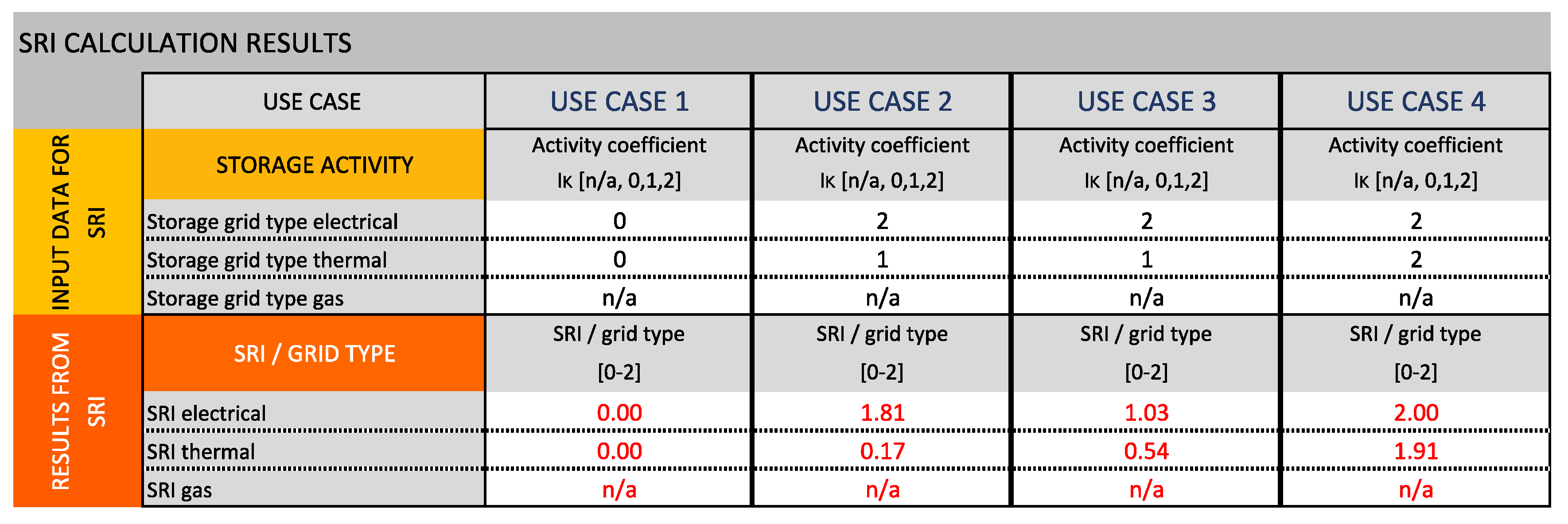
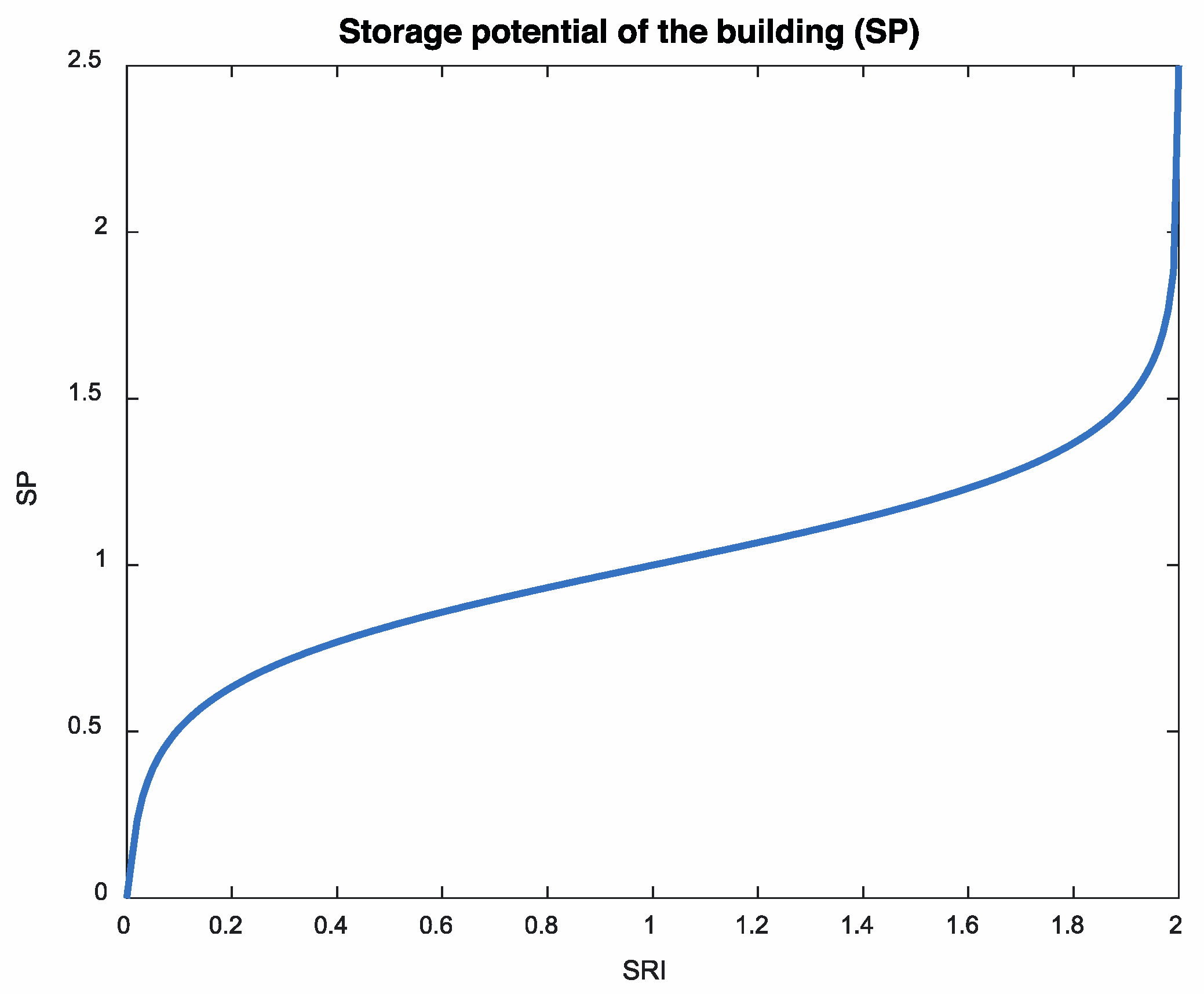
© 2019 by the authors. Licensee MDPI, Basel, Switzerland. This article is an open access article distributed under the terms and conditions of the Creative Commons Attribution (CC BY) license (http://creativecommons.org/licenses/by/4.0/).
Share and Cite
Märzinger, T.; Österreicher, D. Supporting the Smart Readiness Indicator—A Methodology to Integrate A Quantitative Assessment of the Load Shifting Potential of Smart Buildings. Energies 2019, 12, 1955. https://doi.org/10.3390/en12101955
Märzinger T, Österreicher D. Supporting the Smart Readiness Indicator—A Methodology to Integrate A Quantitative Assessment of the Load Shifting Potential of Smart Buildings. Energies. 2019; 12(10):1955. https://doi.org/10.3390/en12101955
Chicago/Turabian StyleMärzinger, Thomas, and Doris Österreicher. 2019. "Supporting the Smart Readiness Indicator—A Methodology to Integrate A Quantitative Assessment of the Load Shifting Potential of Smart Buildings" Energies 12, no. 10: 1955. https://doi.org/10.3390/en12101955
APA StyleMärzinger, T., & Österreicher, D. (2019). Supporting the Smart Readiness Indicator—A Methodology to Integrate A Quantitative Assessment of the Load Shifting Potential of Smart Buildings. Energies, 12(10), 1955. https://doi.org/10.3390/en12101955




